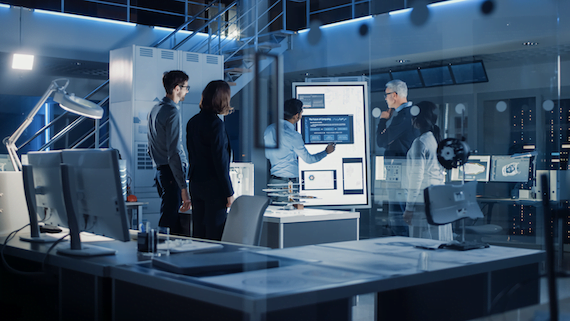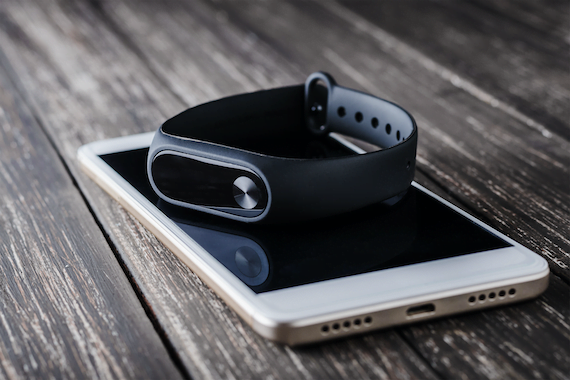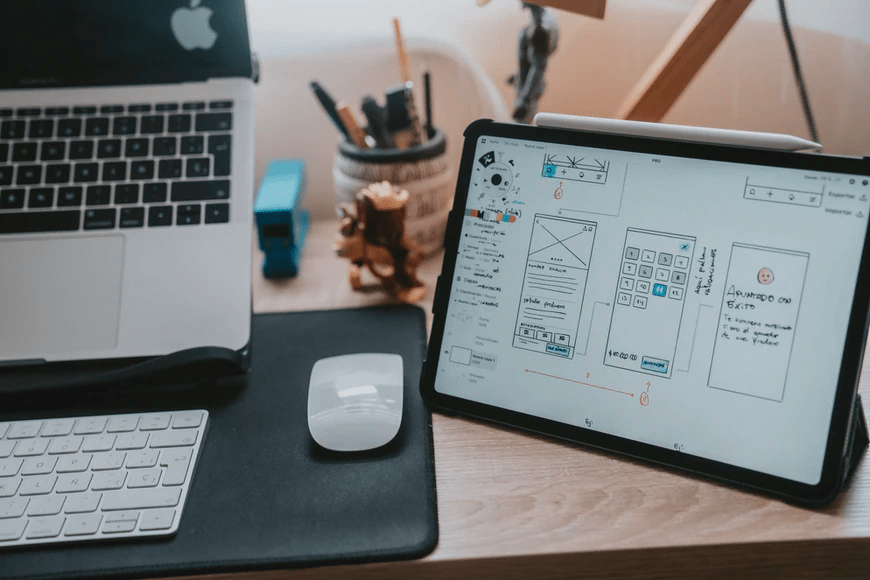Mental health and the use of technology
Dive into the newest mental health tech trends and find more about avant-garde products

Financial services
Expertise in core banking, BaaS integrations, payments, and GenAI-enhanced financial solutions.

Healthcare
People-centric healthcare design and solutions, from virtual care, integrations, to smart devices.

Insurance
Modern solutions including self-service, on-demand, and algorithm-driven personalization.

We’re purposefully shaping the digital future across a range of industries.
Discover some of our specific industry services.
Discover moreJanuary 23, 2024
Join us in discovering wearable medical technology and groundbreaking devices.

Wearable technology in healthcare is going above and beyond the fitness trackers we’re used to. In this article, we will explore some of these emerging technologies, their advantages and mention some of the best wearable health technology devices and products available currently in the market.
One of the hottest markets for wearable medical technology and the Internet of Things (IoT) is in the healthcare space. Projections from early 2020 put wearable health tech revenue at $67.2 billion by 2030.
But what is actually wearable healthcare technology? How can we define this broad concept? Dr. Min Wu and Dr. Jake Luo wrote about wearable technologies in the “Online Journal of Nursing Informatics.” They describe them as technologies that “enable the continuous monitoring of human physical activities and behaviors, as well as physiological and biochemical parameters during daily life.”
Far more powerful than early wellness wearables, like heart rate and activity trackers, today’s healthcare technology includes medical devices used to diagnose and treat disease as well as reduce the number of in-person visits required for patients with chronic conditions. Wearables nowadays have evolved from purely mechanical devices to actually intelligent and proactive systems capable of predicting and helping with the diagnosis of multiple diseases, as well as aiding in the recovery of illnesses. Taking into account the rising challenges that the healthcare industry has been facing in the last few years, these devices are a new frontier that provide insightful data and continuous patient data-collection and monitoring with personalized metrics, gaining a greater efficiency.
To gain insight into the potential of health technology, let’s review some of the positive effects of wearables in the healthcare space and some of the challenges. Then, we’ll take a look at some of the exciting wearable medical devices that are either in development, in the process of securing FDA approval, or on the market today.

Through the use of digital health and wearable medical technology, doctors can connect with their patients via mobile applications and telehealth solutions. This allows them to engage in round-the-clock patient monitoring without being physically present.
The use of wearable devices in healthcare offers numerous benefits and advantages to both patients and health care providers. Some of the most important benefits include:
The increasingly greater usage of wearables, its functionality and ability to capture vast amounts of patient data is already benefiting both doctors and patients. But, there are still some challenges to consider in wearable tech.

As with many emerging technologies, with positive outcomes also comes risk and unanticipated challenges to tackle. With digital health devices, two primary areas cause concern.
As with any mechanical device, the opportunity exists for malfunction, misuse, or misinterpretation of results. This is why it’s important for patients and health care providers to work together when wearable tech is being used.
Of course, users can run into difficulty if a device’s batteries wear out or they’re out of range of a Wi-Fi connection. However, a patient may also experience malfunctions that cause their readings or data to be inaccurate.
Wearable tech designers, developers, and device manufacturers do have a responsibility to protect users and to build in safeguards. However, consumers of these technologies also have a responsibility to question information received, especially if there’s a mismatch between symptoms and digital output.
One of the primary benefits of wearable devices is the amount of data available for patients and doctors to analyze and to act upon. But, with that data comes the risk of data breaches and the stored information falling into the wrong hands.
Developers of wearable health tech must be diligent about following HIPAA regulations and protecting data stored in electronic health records (EHRs). Particularly important when sharing clinical trial data, any use of EHRs must follow strict data anonymization practices to prevent breaches of personal information leaking into the public realm.

Let’s take a look at some of the best wearable health technology and health tech startups that are making headlines in the digital health space. Some of these innovations are still in development, while others are already available on the market.
A biomarker for cancer treatment, circulating tumor cells (CTCs) are typically collected and analyzed from blood samples. While blood draws are less invasive than a biopsy, CTC tests have two main drawbacks: A typical blood draw is a very small amount of blood to perform tests, and CTC cells aren’t always present in sufficient quantity at the exact time of the blood draw.
Researchers at the University of Michigan are developing a wearable medical device that detects and measures CTCs continually over a period of time, resulting in the analysis of a larger blood sample and more conclusive findings through machine learning techniques. Expected to be ready for human testing in the next couple of years, if successful, this device could be a game-changer for early cancer detection, potentially eliminating the need for the most toxic treatments and saving more lives
Hypertrophic cardiomyopathy (HCM) is a disease that causes an abnormal thickening of the heart. While difficult to diagnose, HCM can lead to heart disease, stroke, and fatal cardiac incidents.
Researchers developed a biosensor that will integrate into other smartwatches or wrist wearables that are capable of monitoring and tracking changes in blood volume. By applying artificial intelligence methods, the biosensor data accurately predicted cases of HCM that may have otherwise gone undiagnosed until the heart disease progressed and exhibited more severe symptoms.
With heart disease being the leading cause of death in the U.S., the integration of this sensor with popular wearable devices could have a dramatic life-saving impact through early detection of cardiovascular disease.

If you’ve ever cared for a sick child, you can relate to the worry and anxiety that comes with temperature spikes. If that child is a baby or a toddler, it can be a challenge to get an accurate temperature.
Developed by Blue Spark Technologies, TempTraq is the only single-use, Bluetooth-enabled thermometer on the market, promising peace of mind for parents and uninterrupted rest for the child. Monitoring a temperature for 24 hours, the comfortable patch is applied to the child’s skin and connects to the parent’s smartphone, alerting them if the temperature spikes.
Omron, the creator of HeartGuide, developed this wearable sensor to monitor blood pressure as well as track physical activity and sleep patterns. The inflatable cuff looks like a smartwatch and is worn on the patient’s wrist. The companion app stores data and provides an easy way to identify trends through a graphical user interface.
The HeartGuide alerts the wearer of blood pressure readings outside their normal range so patients can check in with their doctors. The fitness trackers allow users to set goals and monitor how their daily activities affect their blood pressure.
The Dexcom G6 Continuous Glucose Monitoring (CGM) System is a wearable sensor self-inserted just below the skin’s surface. The sensor detects glucose levels and sends that data to a receiver or other compatible smart device.
The device allows users to set upper and lower monitoring limits and receive notifications when those limits have been breached. The system also includes data reporting that can be emailed to a health care provider and graphs that show glucose levels over time.

Used in treatment centers and recovery communities, ViviHealth’s insight platform Vivi360 leverages different wearable health tracking devices to monitor patient recovery, in addition to using machine learning to identify negative and positive impacts of specific events, and warning about potential risks to sobriety.
A treatment dashboard for clinicians and a companion mobile app for patients provide real-time care designed to promote lasting recovery and reduce relapses. The product also includes a telehealth platform for remote activity monitoring and interactive care.
Owlet Baby Care created the Smart Sock designed for babies 1-18 months old. The device slips on the baby’s foot and is designed to be worn alone, under a sock or under footie pajamas. The Smart Sock monitors heart rate and oxygen levels, watching for any readings outside a safe range.
Parents can rest easy during nap time and at night. If an irregular heart rhythm or oxygen level is detected while the parents are asleep, the Owlet Smart Sock will alert the parents through a smartphone app.

Whether you have the next device to treat chronic disease through a Fitbit or have a vital-sign sensor to attach to an Apple Watch, the healthcare wearable technology market is exploding.
To hit the ground running, make sure you partner with a technology firm experienced in the healthcare industry such as Qubika. Whether you’re a startup or an established company, we can work together from concept to launch, and we’ll have your back when it comes to data protection, HIPAA regulations, and EHR security.

President
Receive regular updates about our latest work
Dive into the newest mental health tech trends and find more about avant-garde products

Learn how the latest trends are leading the evolution of Digital technology in healthcare

Read about why UX design is a crucial part of telemedicine app design.

Receive regular updates about our latest work
Get in touch with our experts to review your idea or product, and discuss options for the best approach
Get in touch